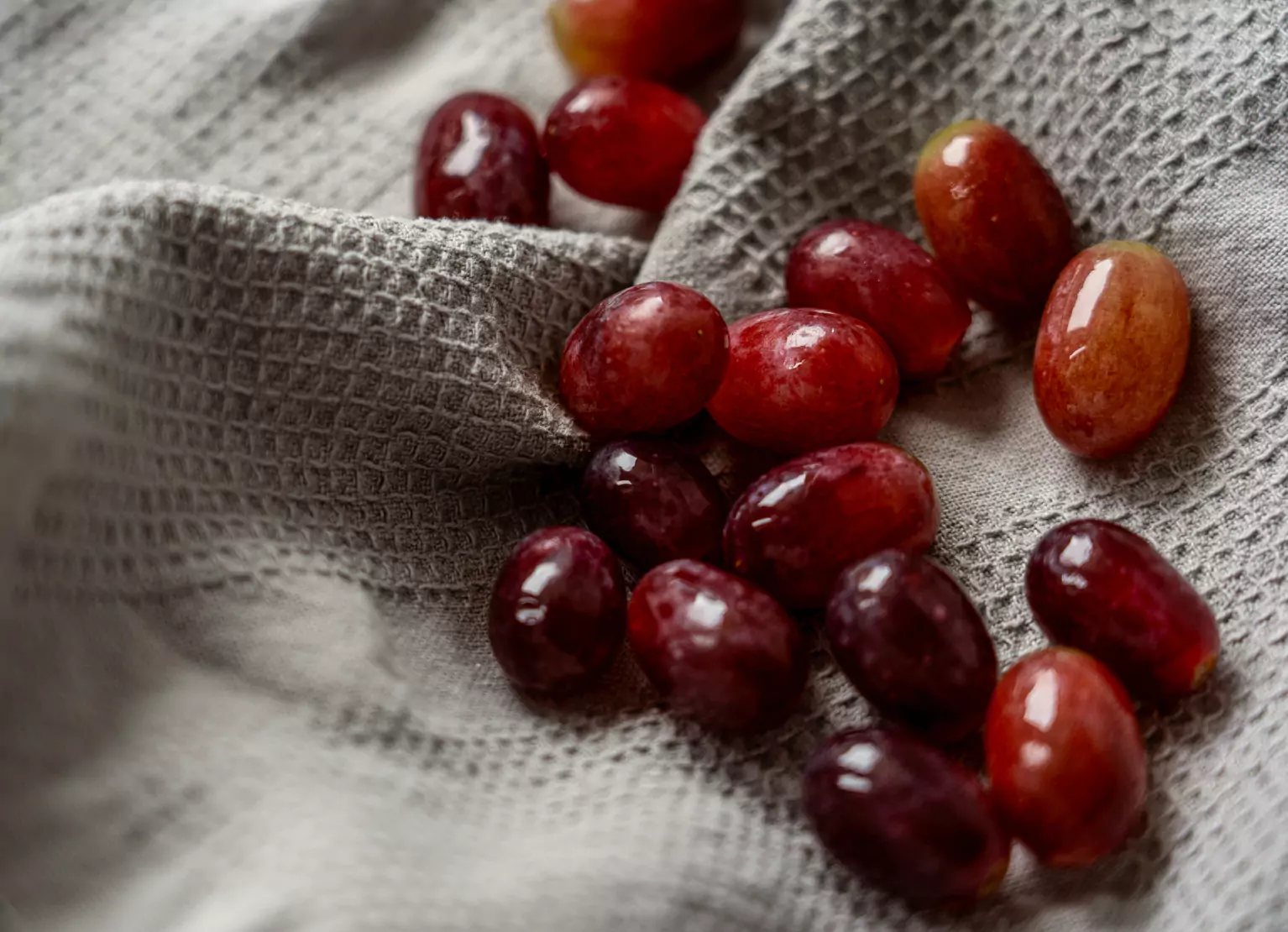Do Grapes Raise Blood Sugar Levels?

Key Takeways
Grapes have been grown since as early as 6500 BC, and there are countless ways to incorporate them into your diet. From table grapes to raisins, jams, wine, grape juice, and grape seed oil, there are countless ways to do so. As of 2022, 6.05 million tons of grapes are now produced annually in the United States, meaning that this versatile and popular fruit is very likely to show up in your diet from time to time.
As carbohydrates, grapes are a great energy source and contain antioxidants and micronutrients. However, while they may pose a problem for some people with diabetes due to their high sugar content, you might be surprised to learn that grapes also have a low glycemic index (or low GI), which could lower their blood glucose impact.
So, are grapes safe for people with diabetes to include in their diet? Do they raise your blood sugar levels, lower them, or have no significant effect on them at all? Read on to find out.
Types of Grapes
You may be familiar with green grapes, red grapes, black grapes, and seedless grapes. These are all varieties of table grapes you'd typically find in your local grocery store. But there are over 10,000 types of grapes grown worldwide and used to make everything from wine to jam.
Table grapes tend to be larger and less acidic than wine grapes, which contain lots of seeds and are cultivated to be sweeter. Despite their different flavors, all grapes are low in calories, with about 30 calories per half cup of grapes.
From wine favorites chardonnay, merlot, riesling, and pinot noir varieties to common vine and Concord, here are some of the most popular types:

- Concord
- Common vine
- Candice
- Cotton candy
- Red globe
- Chardonnay
- Merlot
- Riesling
- Pinot noir
Grapes and Blood Sugar Levels
If you're trying to keep your sugar intake within a healthy range, grapes might be something you've hesitated to add to your diet because of their high sugar content and lack of protein and fat. The sugar in grapes is made up of glucose and fructose, which are quickly digested by the body.
Due to their sugar content, you might be surprised to learn that grapes have a low GI, meaning that some diabetes diets may be able to include them safely due to their low glycemic load.
Besides their low-GI content, red grapes have polyphenols, including resveratrol, quercetin, catechins, and anthocyanins. These compounds have been observed to potentially reduce hyperglycemia and high blood sugar and may benefit people with type 2 diabetes. These polyphenols are also effective in managing kidney disease and improving insulin sensitivity.
Although human studies evidence has shown that grapes are safe for people with diabetes to eat, it's essential to consume them in moderation and watch your portion sizes.
Some Health Benefits of Grapes

As a fruit, grapes possess many health benefits that can be great to include as part of a balanced diet. One important thing to note is that while all grapes contain similar nutritional value, red and other darkly colored fruits have been found to contain more flavonoids and phytonutrients than white grapes.
Some types of grapes, like Concord or red grapes, may contain a higher antioxidant content.
Grapes Have Antioxidants and Phytonutrients
Berries and other dark-colored whole fruits (like blueberries) are typically high in antioxidants and other disease-fighting micronutrients, and red grapes are no exception. Many varieties of grapes may be helpful in preventing diseases induced by oxidative stress, such as cardiovascular disease and cancer, due to the flavonoids they contain. In addition to their high antioxidant content, grapes have been found to have anti-inflammatory qualities.
You May Experience a Reduced Risk of Heart Disease
The flavonoids and resveratrol found in red grapes may help prevent heart disease and reduce the risk of high blood pressure and respiratory diseases. A study found that polyphenols in grapes may also have a positive effect on lowering LDL cholesterol levels in the blood.
Grapes Can be Good for Brain and Bone Health

Grapes contain micronutrients like vitamin K, magnesium, and potassium, essential for healthy bones. Some compounds found in grapes may help reduce risk factors for certain diseases, but more research is needed.
Grapes May Help Lower Insulin Resistance
Can grapes lower your risk of type 2 diabetes? There's not enough evidence to say 'yes' with any certainty. Certain compounds in grapes may help reduce oxidative damage and improve insulin sensitivity. However, whether all diabetics can tolerate their carbohydrate levels or note does require individual assessment.
Grapes Are a Good Source of Dietary Fiber
Apart from containing healthy micronutrients, the peels of grapes are also high in fiber. Fiber is essential for feeling full and satisfied between meals and can help regulate your blood glucose levels and improve digestion. Including fiber from fruits and vegetables can also help prevent conditions like heart disease, cancer, and diverticular disease.
So, Are Grapes Safe for People with Diabetes?

The short answer is yes. Eating grapes is perfectly safe in moderation, even for those with diabetes. Fresh fruit can be included as part of a healthy, balanced diet, and grapes are a good source of dietary fiber and contain vitamin C, vitamin A, and copper.
Whether you have diabetes or not, including a variety of fresh and nutrient-packed fruits and vegetables as part of your daily diet is important. Remember that adding different colored fruits and vegetables into your diet is beneficial and can help you get all those vital phytonutrients they contain.
While eating grapes is not a cure for health conditions like type 2 diabetes, they contain many compounds and micronutrients that have health benefits. Add grapes to your meals now and then to satisfy your sugar cravings, but keep an eye on how many you're eating along the way.
How to Add More Grapes to Your Diet
Grapes are one of the most versatile fruits out there, and there are many creative ways to sneak some extra grapes into your meals to enjoy their health benefits. There are a few habits you can adopt in your blood sugar management plan to prevent your blood sugar from spiking while still enjoying foods you love.
Eating carbohydrates on their own can lead to sharp spikes in blood sugar as the body breaks them down for energy. However, when you combine carbs with fiber and protein sources, you slow down your digestion process, reducing blood sugar spikes.
1) Toss Grapes into a Salad or Savory Dish
Everyone loves a sweet and salty combo in their salads. Including carbs with fiber, protein, and moderate fat can be helpful for some people to support more stable glucose levels. Try throwing some cut-up grapes into a chicken salad for a light, tasty meal with protein and fats, which can help slow glucose levels from rising in the blood.
2) Make a Grape Smoothie
The sweet nature of grapes makes them a great ingredient to toss into a smoothie if you're on the go. You can also include a dairy or fat source like unsweetened Greek yogurt or nut butter to balance your glucose response and get a good serving of all macronutrients.
3) Replace Grape Jelly with Fresh Grapes
Jellies and jams might be delicious, but they can contain more than nine grams of added sugars per tablespoon. The next time you make a peanut butter and jelly sandwich, try swapping the jelly for crushed, fresh grapes. The peanut butter, which also has a low GI, will help balance the carbohydrates in the bread.
4) Add Grapes to a Snack Platter
For a midday snack, try adding a handful of grapes to a cheese and nut plate for an extra touch of sweetness. This healthy balance of macronutrients is a great way to get extra vitamins and minerals into your diet, satisfy your sweet tooth, and improve glucose stability.
5) Consider Adding Grape Seed Extract to Your Diet
Don't underestimate the beneficial effects of grape seed. Derived from these seemingly useless parts of the grape, the grape seed proanthocyanidin extract boasts potent antioxidants offering protective effects against various health conditions.
These include cardiovascular disease, inflammation, hypertension, diabetes, cancer, microbial infections, and peptic ulcers. Incorporating grape seed extract into your diet can offer numerous benefits for overall well-being.
Some ways to include it in your diet are by taking supplements (remember to speak with a health expert before adding any new supplements to your diet) or including it as an ingredient in recipes, such as adding it to salad dressings or smoothies.

Considerations When Eating Grapes
Including grapes in your diet can have many health benefits, but there are a few considerations you might want to keep in mind.
Eating more than the recommended serving size of grapes may lead to digestion or bowel issues due to their natural sugar content, so it's important to be mindful of portion sizes. Some people may be sensitive to the natural sugars grapes contain, and testing different amounts to determine individual tolerance can be helpful.
The American Diabetes Association recommends that people with diabetes consume 15 grams of carbohydrates from fruit per serving, which is about 17 small grapes or two tablespoons of raisins..
Find the right Nutrisense programto turn insight into progress.
Engage with Your Blood Glucose Levels with Nutrisense
Grapes are delicious! But remember, like with most foods, moderation is key, as is finding the right balance for your unique body and blood glucose levels. Signing up for Nutrisense gives you access to a continuous glucose monitor (CGM) that can help you figure out what’s best for you.
With access to world-class support from credentialed nutritionists and dietitians, you can interpret your glucose data and get personalized nutrition guidance to optimize your health. By continually monitoring your glucose levels, you can learn how grapes affect you personally and make more informed dietary choices.
Kickstart your journey to better blood glucose levels today. Take our quiz to uncover how Nutrisense can help with all your wellness goals.
Go Beyond Glucose Data with Nutrisense
Your glucose can significantly impact how your body feels and functions. That’s why stable levels are an important factor in supporting overall wellbeing. But viewing glucose isn't enough. Nutrisense, you’ll be able to learn how to use your body's data to make informed lifestyle choices that support healthy living.
One-to-one coaching
Sign up to access insurance-covered video calls to work with a glucose expert: a personal registered dietitian or certified nutritionist who will help tailor your lifestyle and diet to your goals.
Monitor and measure what matters
With the Nutrisense CGM Program, you can monitor your glucose with health tech like glucose biosensors and continuous glucose monitor (CGM)s, and analyze the trends over time with the Nutrisense App. This will help you make the most informed choices about the foods you consume and their impact on your health.
Find your best fit
Ready to take the first step? Start with our quiz to find the right Nutrisense program to help you take control.

Heather is a Registered and Licensed Dietitian Nutritionist (RDN, LDN), subject matter expert, and technical writer, with a master's degree in nutrition science from Bastyr University. She has a specialty in neuroendocrinology and has been working in the field of nutrition—including nutrition research, education, medical writing, and clinical integrative and functional nutrition—for over 15 years.




